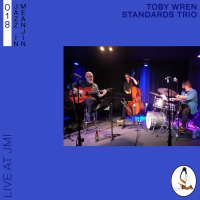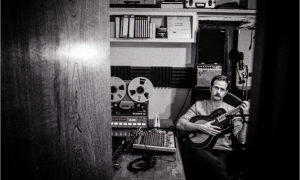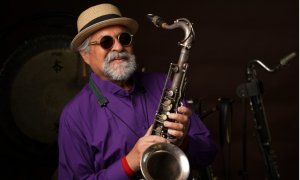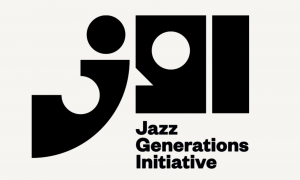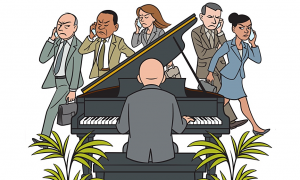
Between 1959 and 1965, Jim recorded six albums with alto saxophonist Paul Desmond that remain among the finest small-group jazz tracks ever recorded. In January 1962, Jim recorded The Bridge with Sonny Rollins, an album that still astonishes for its inventiveness and raw fury. Later that year, Jim recorded Undercurrent with Bill Evans. They recorded another introspective, conversational album, Intermodulation, in 1966. Then in 1975, Jim recorded Concierto, a leadership date that included Paul Desmond and Chet Baker.
In Part 3 of my three-part interview with Jim, the celebrated guitarist talks about Desmond, Sonny, Evans, Baker and the little-known role his singer-songwriter wife Jane played in his recordings:
JazzWax: When did you meet Paul Desmond?
Jim Hall: I met Paul when I still lived in Cleveland in my early 20s. Paul came through town as part of the Dave Brubeck Quartet. I got to know him on a professional level when the Chico Hamilton Quintet worked opposite him on the West Coast. Once I moved to New York in the late 1950s, I'd run into Paul, and we became close. Paul used to come over to my apartment in Greenwich Village all the time to play Scrabble with my wife Janey and me. He also used to come hear me when I played at a club in New York called The Guitar.
JW: Whose idea was it for you and Paul to get together and record for the first time in 1959?
JH: Paul's. Despite all of his acclaim, Paul still gets overlooked in terms of his contribution to jazz. He was such a melodic player. Paul could play a line over a standard that was so much better than the song's original melody line.
JW: You two clearly were in sync with each other creatively.
JH: The closeness comes through on recordings because we liked and admired each other so much.
JW: How did you and Desmond arrange the later albums for RCA?
JH: We rehearsed at my place in Greenwich Village. Paul had such a fantastic melodic sense. Listen to his last phrase on Time After Time on First Place Again [1959]. The melodies Paul would come up with on songs were surprising and pleasing.
JW: Were you listening to each other during those sessions for enjoyment?
JH: Yes, we were. We were entertaining each other. A lot of what we did happened to be in the moment and fed off of what the other was doing. We were very comfortable with each other.
JW: Was playing with Sonny Rollins on The Bridge a tough fit for you?
JH: In some ways, given the music's edge. But I was amazed by Sonny and what he was doing there. It's remarkable, passionate music.
JW: How did Sonny bring you into the group?
JH: A year or so after I had sublet pianist Dick Katz's apartment in the Village in 1960, I started getting these notes from Sonny. The notes would read something like, “Dear Jim, I'd like to speak with you about music."
JW: Why did he send you notes?
JH: He didn't have a phone and I didn't answer mine because I don't like talking on it. I still don't [laughs]. Eventually Sonny came over to the apartment, and we began talking about what he wanted to do. I had already known Sonny for years.
JW: When did you two first meet?
JH: On the West Coast in the mid-1950s. The Chico Hamilton Quintet worked opposite Max Roach's group at Basin Street West in San Francisco.
JW: When Sonny came over to your apartment in New York, what did he say?
JH: We had a nice talk. He said he wanted to get a quartet going but without a piano. I was incredibly flattered.
JW: How were your musical interactions?
JH: We'd be in a middle of a tune and he'd bring it to a halt and we'd just dig in and start exploring it. My role was not to get in Sonny's way but to follow him.
JW: Did Sonny give you any instruction in terms of what he wanted?
JH: Yes, he was pretty clear about that. I wasn't to get in his way when he was playing. My job was to listen and react. I also got to write intros, like the one on God Bless the Child.
JW: You recorded the album What's New with Sonny as well.
JH: Brazilian music was inching up. I had been to Brazil when I was on tour with Ella in 1960, so I had heard the music first-hand. Then when we went to Argentina, I was able to hear accordionist Astor Piazzolla. So I could add those experiences on Night Has a Thousand Eyes, for example.
JW: You recorded two albums with Bill Evans. What was he like?
JH: Bill was a brilliant guy and had a great sense of humor. His parties for close friends at his apartment were memorable. He'd cook dinner and play for his guests. He was introverted, similar in many ways to Paul Desmond in terms of intelligence and wisdom about things. He expressed himself through his playing.
JW: Did you and Evans rehearse the concepts on those albums?
JH: Not really. We got together at his apartment once or twice to go over a few things. Again, I got to know Bill by playing opposite him when he was with Tony Scott's quartet in 1956. Then when I was with Jimmy Giuffre. Then when Jimmy Giuffre replaced the bass in his trio with Bobby Brookmeyer in 1958, we played opposite Bill for eight weeks when he was with the Miles Davis Sextet at the Caf Bohemia. Miles would tease us that our silly little trio would get more applause than his group.
JW: How was John Coltrane?
JH: He sounded incredible. He was constantly searching and looking for new things. It's a shame most people remember him best for playing fast. It's Coltrane's slower pieces, his ballads, that stand out to me, where you can really hear his thinking and ideas.
JW: You never recorded with Miles Davis.
JH: No. I did get to play with Philly Joe Jones when Bill Evans had his quintet in 1962. Miles called me a couple of times for playing dates, and I almost recorded with him on Miles in the Sky in 1968. [Pictured: Miles Davis and Bill Evans]
JW: What happened?
JH: After Janey and I were married, I began playing the Merv Griffin Show regularly. It was a perfect job. I could take the subway to work. It was dumb music, but it was steady. When Miles called, I had to work the show and suggested that he call George Benson. I first met Miles at John Lewis' apartment in the late 1950s.
JW: What happened?
JH: When John brought me to New York in the late 1950s, I stayed with him. That's how I met Miles. Miles then invited me over to his apartment and played me a recording of Joaquin Rodrigo's Concerto de Aranjuez. He said he wanted to get Gil Evans to arrange it. The result in 1960 was an adaptation for Sketches of Spain.
JW: Did you enjoy recording the duet album Alone Together with Ron Carter?
JH: Very much so. Ron and I are still close. We still play together and talk all the time. I think we're close because we both listen to each other and react beautifully. Ron has such a strong sense of harmony, and I try not to step on it. I just fill it out.
JW: Who came up with the idea for Concierto?
JH: [Producer] Creed Taylor. He assembled a great group of musicians. Chet Baker was incredible on there. We even recorded a tune by my wife Janey--The Answer Is Yes. The credit says “J. Hall," but the “J" stands for Janey, who's an accomplished musician in her own right. She studied and worked with pianist Hall Overton. When Chet played down the song, he said, “A chick wrote that tune? Wow" [laughs]. [Pictured: Jane and Jim Hall]
JW: How did you meet your wife?
JH: I met Janey through Dick Katz. They had a date that didn't work out and realized they weren't really serious.
JW: Jane also wrote O Gato on Bossa Antigua, didn't she?
JH: Yes. She's a wonderful songwriter and singer.
JH: What's next for Jim Hall?
JW: I'm going to start touring in April with Scott Colley and Joey Baron.
JW: You still love performing?
JH: Absolutely. I love the connection I get with audiences in clubs.
Jazzwax backstory: Yesterday I asked Jane Hall for the stories behind two of her most famous songs that Jim recorded, The Answer Is Yes and O Gato:
“The Answer Is Yes was the headline on a profile of Jim in The New Yorker in 1975 by Whitney Balliett. Whitney came to our house for five days to interview Jim. In the magazine interview, Jim speculates on his future. At one point Jim asks himself whether he would be happy playing saloons when he was 50, 60 or 70 years old. Jim responds aloud to his own question: 'The answer is yes.'
“O Gato [the Cat] was named after a cat we had at the time named Pablo. At first the song didn't have a bridge. But when Paul recorded it, I was so inspired by his melodic improvising that I wrote the bridge. I also wrote the song's lyrics.
“Jim has kindly recorded a few of my tunes over the years, including Goodbye My Love, Something Tells Me and Where Would I Be--all of which have words that I wrote. He also recorded my instrumental, It's Nice to Be With You."
JazzWax tracks: Jim Hall's recordings with Paul Desmond are must-owns. Their first recording together was First Place Again in 1959 for Warner Brothers. The remaining five albums were recorded for RCA. The complete RCA recordings are available at iTunes. Or an imported CD box is available here. First Place Again is available as an import here.
Jim Hall with Sonny Rollins can be found on The Bridge (also a must-own) and What's New, both for RCA. Though the latter album is a bit spotty, The Night Has a Thousand Eyes is tremendous and appears on several compilations at iTunes.
Jim Hall and Bill Evans recorded Undercurrent for Blue Note in 1962 and Intermodulation in 1966 for Verve. Both duo albums are fascinating studies in understated, poignant playing. Undercurrent is the moodier recording while Intermodulation has a bit more get up and go.
Concierto was recorded in 1975 for CTI. It features Chet Baker (trumpet), Paul Desmond (alto sax), Sir Roland Hanna (piano), Jim Hall (guitar), Ron Carter (bass) and Steve Gadd (drums). It's a relaxed session, though its cool temperament can be deceiving. All of the pros on the date make the execution seem easy.
For more on Jim Hall and his upcoming tour, visit his site here.
Jazzwax clip: Here's a clip of Jane Hall in the 1970s singing her composition O Gato, with Jim Hall accompanying. For contrast, it's followed by Jim and Paul Desmond's famed recording of the song from the album Bossa Antigua...
This story appears courtesy of JazzWax by Marc Myers.
Copyright © 2025. All rights reserved.







